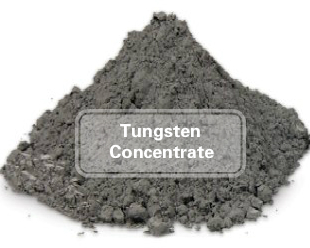Tungsten Concentrate
- Linear Formula:
- W
- CAS Number:
- 7440-33-7
- EC No:
- 231-143-9
- Molecular Weight:
- 183.85
- Appearance:
- Silvery
- Melting Point:
- 3410 °C
- Boiling Point:
- 5900 °C
- Density :
- 19.3 g/cm3
- Thermal Expansion:
- (25 °C) 4.5 µm•m-1•K-1
- Poisson Ratio:
- 0.28
- Vickers Hardness:
- 3430 MPa
- Heat of Vaporization:
- 806.7 kJ/mol
- Heat of Fusion:
- 35.3 kJ/mol
Tungsten, also known as wolfram, is a chemical element with symbol W and atomic number 74. A hard, rare metal under standard conditions when uncombined, tungsten is found naturally on Earth almost exclusively in chemical compounds.
Its important ores include wolframite and scheelite. The free element is remarkable for its robustness, especially the fact that it has the highest melting pointof all the elements. Its high density is 19.3 times that of water, comparable to that of uranium and gold, and much higher (about 1.7 times) than that of lead. Polycrystalline tungsten is an intrinsically brittle and hard material, making it difficult to work. However, pure single-crystalline tungsten is more ductile, and can be cut with a hard-steel hacksaw.
Tungsten's many alloys have numerous applications, including incandescent light bulb filaments, X-ray tubes (as both the filament and target), electrodes in TIG welding, superalloys, and radiation shielding. Tungsten's hardness and high density give it military applications in penetrating projectiles. Tungsten compounds are also often used as industrial catalysts.
Tungsten is the only metal from the third transition series that is known to occur in biomolecules, where it is used in a few species of bacteria and archaea. It is the heaviest element known to be essential to any living organism.
Its important ores include wolframite and scheelite. The free element is remarkable for its robustness, especially the fact that it has the highest melting pointof all the elements. Its high density is 19.3 times that of water, comparable to that of uranium and gold, and much higher (about 1.7 times) than that of lead. Polycrystalline tungsten is an intrinsically brittle and hard material, making it difficult to work. However, pure single-crystalline tungsten is more ductile, and can be cut with a hard-steel hacksaw.
Tungsten's many alloys have numerous applications, including incandescent light bulb filaments, X-ray tubes (as both the filament and target), electrodes in TIG welding, superalloys, and radiation shielding. Tungsten's hardness and high density give it military applications in penetrating projectiles. Tungsten compounds are also often used as industrial catalysts.
Tungsten is the only metal from the third transition series that is known to occur in biomolecules, where it is used in a few species of bacteria and archaea. It is the heaviest element known to be essential to any living organism.


